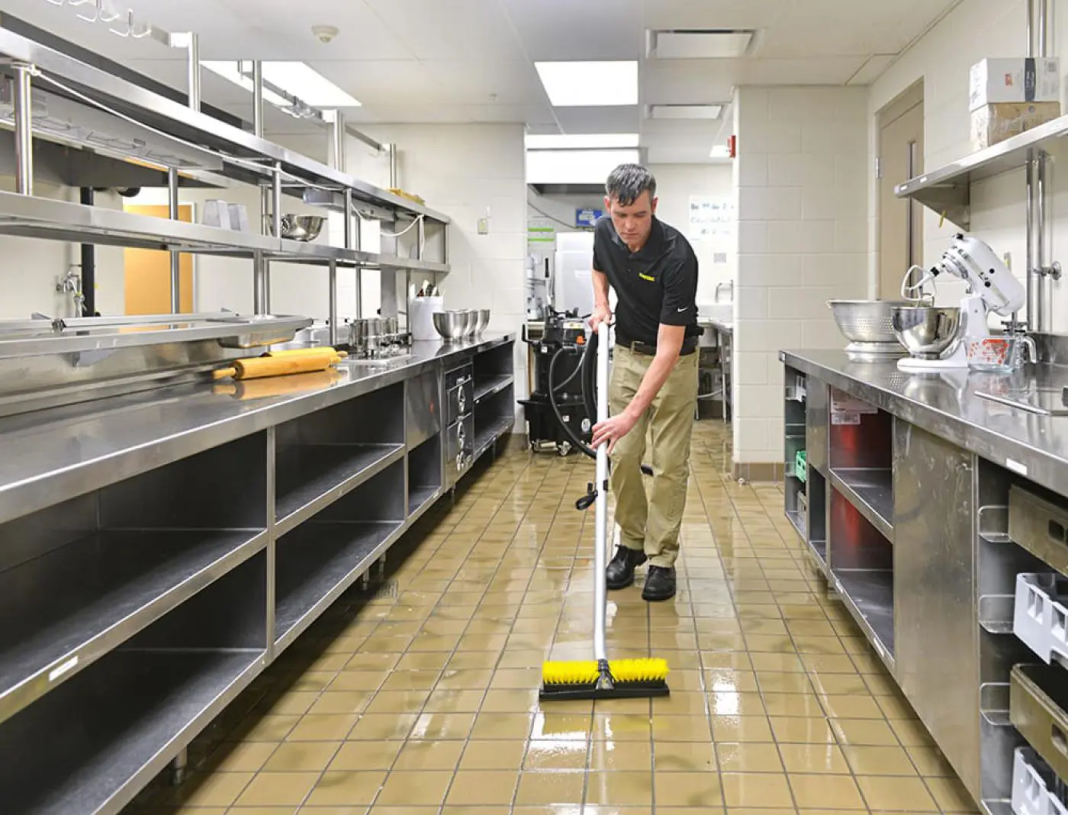In the bustling world of restaurants, where the spotlight often shines on tantalizing dishes and the ambiance of the dining area, the kitchen – the heart of the restaurant – sometimes remains in the shadows. Yet, it is here, behind the scenes, where the magic of culinary creation meets the crucial responsibility of maintaining hygiene and safety standards. The cleanliness of a restaurant kitchen goes far beyond mere aesthetics; it is a fundamental aspect that can make or break a restaurant’s reputation and success.
In this comprehensive guide, we delve into the often-overlooked aspects of restaurant kitchen cleanliness, highlighting how professional cleaning can prevent cross-contamination and other hazards, thus safeguarding both the patrons and the establishment’s integrity.
The Hidden World of Kitchen Hygiene
1. Cross-Contamination: An Invisible Threat
In the confined spaces of a restaurant kitchen, cross-contamination is a silent but pervasive menace. This process occurs when harmful bacteria or allergens are unintentionally transferred from one food item to another, primarily due to inadequate cleaning practices. For instance, using the same cutting board for chopping raw chicken and then preparing a salad without proper sanitation can lead to serious health risks for customers.
Professional cleaning services play a crucial role in mitigating these risks. Unlike routine wipe-downs, professional cleaners use industrial-grade sanitizers and follow systematic cleaning protocols that target high-risk areas such as cutting boards, utensils, and work surfaces. Their expertise ensures that these areas are not just visibly clean but also sanitized to meet rigorous health standards, effectively breaking the chain of cross-contamination.
2. The Dangers Lurking in Equipment and Storage Areas
Equipment and storage areas in a restaurant kitchen can be hotspots for bacteria and pest infestation if not properly maintained. The build-up of grease in an exhaust hood, for example, is not only a fire hazard but also a breeding ground for bacteria. Similarly, improperly cleaned storage areas can attract pests like rodents and insects, which pose a significant health risk.
Here, professional cleaning services offer a level of thoroughness that goes beyond the scope of daily cleaning routines. They have the tools and knowledge to deep-clean hard-to-reach areas and complex equipment. Professionals can dismantle and clean components of kitchen equipment that are often neglected, such as the interior parts of ovens or ice machines, ensuring a comprehensive clean that prevents the growth of harmful bacteria and deters pests.
3. Regular Cleaning versus Reactive Measures
A common mistake in many restaurants is to wait until there’s a visible problem before taking action. This reactive approach not only compromises hygiene but can also lead to more costly interventions later on. Regular professional cleaning pre-empts these issues by maintaining a consistently high standard of cleanliness, ensuring that potential problems are dealt with before they escalate.
This proactive approach is particularly vital in high-risk areas such as refrigerators and freezers, where the correct handling and storage of food are crucial for safety. Professional cleaners ensure that these critical areas are regularly defrosted, cleaned, and sanitized, maintaining an environment that is both hygienic and conducive to food preservation.
Professional Cleaning: A Necessity, Not a Luxury
1. Deep Cleaning vs. Surface Cleaning
Understanding the distinction between surface cleaning and deep cleaning is crucial for restaurant kitchens. Surface cleaning, typically done by the staff, includes wiping down counters, sweeping floors, and basic equipment maintenance. While important for day-to-day operations, it barely scratches the surface of what’s needed in a high-use kitchen environment.
Deep cleaning, on the other hand, is where a provider of restaurant cleaning services shines. These professionals employ comprehensive methods that target every nook and cranny of the kitchen. This includes degreasing high-use areas, thoroughly cleaning appliances both inside and out, and sanitizing surfaces to a degree that regular cleaning cannot achieve. Moreover, deep cleaning targets areas that are often missed or inaccessible during routine cleanings, such as the tops of cabinets, beneath heavy appliances, and inside ventilation systems.
2. The Role of Professional Cleaning in Health Inspections
Health inspections are a crucial aspect of running a restaurant, and the cleanliness of the kitchen is a significant factor in these evaluations. A provider of restaurant cleaning services doesn’t just clean; they prepare your kitchen to meet and exceed health standards. Regular professional cleaning ensures that every part of the kitchen is up to code, which is critical for passing surprise health inspections.
Professional cleaners are familiar with the guidelines and expectations of health inspectors. Their services include focusing on areas that are critical to health inspectors, such as proper sanitation of food preparation areas, correct disposal of waste, and the overall hygiene of the cooking environment. This level of preparedness provided by professional cleaning can make the difference between a passing and failing grade during inspections.
3. Long-Term Cost Savings with Professional Cleaning
Investing in professional cleaning services may seem like an added expense, but it can lead to significant cost savings in the long run. Kitchens that are regularly and thoroughly cleaned experience fewer equipment malfunctions and breakdowns, as build-ups of grease and debris are major contributors to equipment failure. Regular maintenance extends the life of expensive kitchen equipment, saving money on costly repairs and replacements.
Additionally, professional cleaning helps avoid health hazards that could result in fines or temporary closure by health inspectors. These disruptions are not only costly in terms of immediate expenses but can also damage a restaurant’s reputation, leading to a long-term impact on revenue.
Implementing Effective Cleaning Protocols
1. Creating a Balanced Cleaning Schedule
An effective cleaning schedule is paramount in restaurant kitchen maintenance. It should encompass daily, weekly, and monthly tasks, balancing in-house cleaning with the more intensive procedures carried out by professional cleaners. Daily tasks might include wiping down surfaces and cleaning floors, while weekly tasks could involve a deeper clean of certain appliances and areas. Monthly tasks, often handled by professional services, should focus on extensive cleaning that covers every aspect of the kitchen.
Consistency is key. Ensuring that these tasks are performed regularly prevents the build-up of grease and dirt, which can become overwhelming and more difficult to clean over time. It also maintains a continuously high standard of hygiene.
2. Training Staff in Proper Cleaning Techniques
While professional cleaners play a crucial role, the daily upkeep of the kitchen rests in the hands of the restaurant staff. Training them in proper cleaning techniques and the use of appropriate cleaning agents is essential. This training should include understanding the right cleaning materials for different surfaces, the correct use of sanitizing agents, and the importance of following a cleaning schedule.
Staff should also be trained in recognizing potential hygiene issues and understanding the importance of addressing them promptly. This proactive approach ensures that the kitchen maintains a baseline level of cleanliness between professional cleaning sessions.
3. Embracing Technological Advancements in Cleaning
Modern kitchens can benefit from the latest advancements in cleaning technology. From eco-friendly cleaning products to high-efficiency particulate air (HEPA) filter vacuums and automated cleaning systems, these technologies can enhance cleaning efficiency and effectiveness. Embracing these advancements shows a commitment to maintaining a state-of-the-art, hygienic kitchen environment.
The Cornerstone of a Successful Restaurant
The cleanliness of a restaurant’s kitchen is not just a regulatory requirement; it is the cornerstone of its success and reputation. Behind every great meal served is a clean and hygienic kitchen, maintained through the diligent efforts of the staff and the expertise of professional cleaning services. A clean kitchen ensures the safety and satisfaction of customers, contributes to the efficiency and longevity of the kitchen’s operation, and reflects the overall quality of the establishment.
In the bustling and competitive world of restaurants, overlooking the importance of kitchen cleanliness can have far-reaching consequences. By implementing effective cleaning protocols, training staff adequately, and utilizing the services of professional cleaners, restaurants can uphold the highest standards of cleanliness and hygiene. This commitment to cleanliness not only meets the regulatory requirements but also builds a foundation of trust and excellence with patrons, ensuring the restaurant thrives in an ever-evolving culinary landscape.










